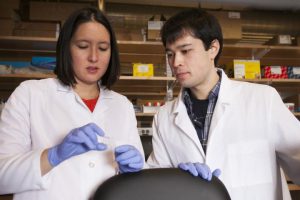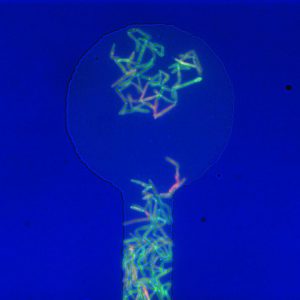Why Individual Mycobacteria Respond Differently to Antibiotics

Tufts University assistant professor Bree Aldridge (left) and research technician Owen Bennion (right) examine a microfluidic device used to study how individual bacteria respond to antibiotics. Credit: Kelvin Ma/Tufts University
Tuberculosis infects almost 10 million people every year and is challenging to treat. Treatment consists of multiple antibiotics taken over several months, partly because of variations in antibiotic tolerance among subpopulations of the tuberculosis-causing bacteria Mycobacterium tuberculosis.A specific combination of factors that determine why individual mycobacteria of the same genetic background can respond differently to antibiotics has been identified by researchers from Tufts University School of Medicine. Bacteria most likely to respond to antibiotics were smaller at birth and at the beginning or end of their cell division cycles. In contrast, larger cells in the middle of a cell cycle were the most tolerant. These findings were published in the Proceedings of the National Academy of Sciences on June 30, 2016.
The study was based on Mycobacterium smegmatis, a fast-growing, non-pathogenic relative of M. tuberculosis. Using live-cell microscopy, microfluidic and imaging tools, and mathematical models, the researchers analyzed the responses of individual bacteria to rifampicin, a core frontline antibiotic used to treat tuberculosis.

Small colonies of genetically identical mycobacteria growing in a microfluidic chamber. Individual mycobacteria will respond differently when exposed to a common antibiotic, depending on growth and timing factors. Credit: Aldridge lab
“Our study shows that bacteria in a population that we thought of as being identical are actually not. Even simple differences such as how big they are at birth correlate with differences in how they respond to drug treatment,” senior study author Bree Aldridge, Ph.D., assistant professor of molecular biology and microbiology at Tufts University School of Medicine and adjunct assistant professor of biomedical engineering at Tufts University School of Engineering, said in a press release. “We hope we can eventually use these insights to help engineer new, rational drug combinations that can more effectively treat tuberculosis and other diseases by specifically targeting the cells that are slower to respond to antibiotics.”
Genetically identical, with different responses
Previously, the research team had demonstrated that mycobacteria divide asymmetrically; despite being genetically identical, one daughter cell will usually be longer and faster-growing than the other. Now, the team has discovered that these longer bacteria were least affected by rifampicin. They also found that bacteria which inherited a mature growth pole, the cellular structure where growth originates, from its mother cell were also slower to respond to the antibiotic.
The cell division cycle phase that bacteria were in when exposed to the antibiotic also had a significant effect. Rifampicin-susceptible bacteria were small and at the beginning stages of their cell cycles, or larger and at the end stages of their cell cycles. Bacteria in the middle of their cell cycle were least affected by the antibiotic.
“By simply watching cells grow, we were able to characterize several differences between bacteria that are killed quickly and those that respond slowly to antibiotics,” Dr. Aldridge added. “We hope to refine these multivariable descriptions so that we can anticipate the cyclic changes to drug susceptibility in mycobacteria, and eventually use them to shorten the long and difficult treatment course for tuberculosis.”
Do you work in this area of science? Check out our available bacteriology reagents to see if any could help accelerate your research. You also might be interested in other recent blog posts covering antibiotic research:


